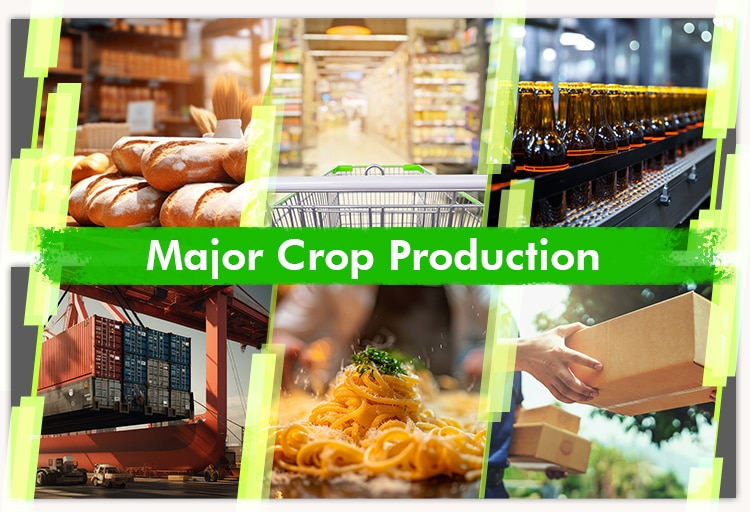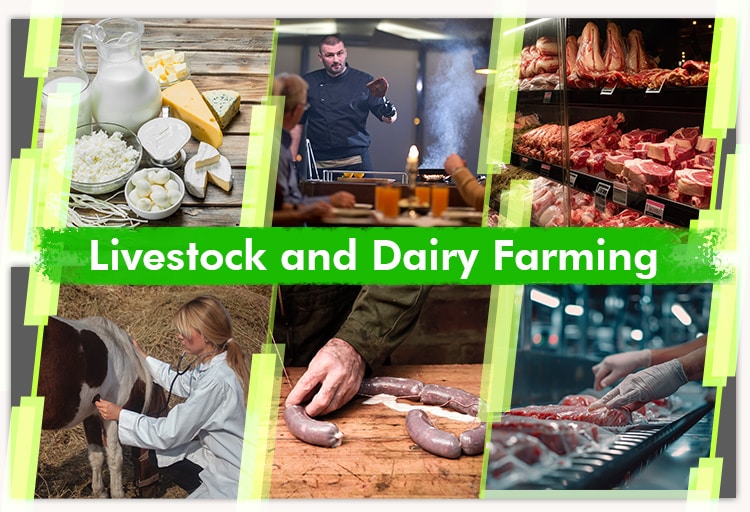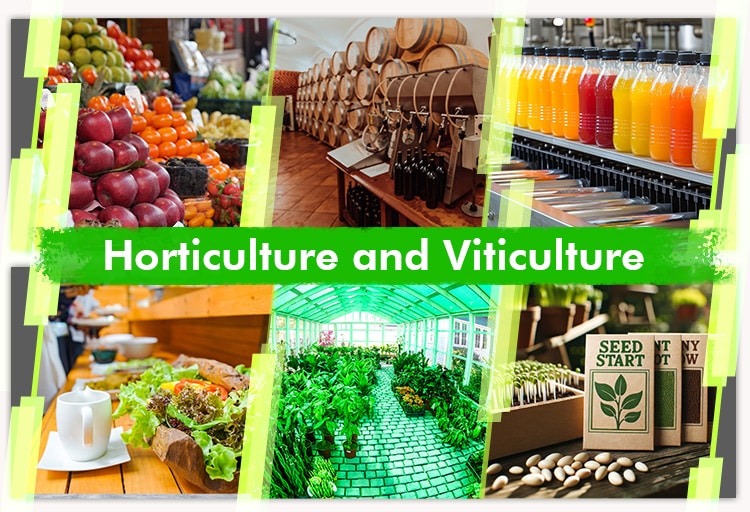Agriculture and agribusiness is one of Australia’s oldest and most significant industries.
According to Australia’s Department of Agriculture, Fisheries, and Forestry (DAFF) 2024 snapshot, it accounts for 55% of Australian land use and 74% of water consumption.
In addition, agriculture and agribusiness constitutes 13.6% of goods and services exports, 2.7% of value added (GDP), and 2.2% of employment in 2022-23.
Furthermore, the gross value of agricultural production is projected to increase by 2% from AUD 82 Billion in 2023-24 to AUD 84 Billion in 2024-25.
So, how can AU businesses tap into this industry, and what does the agricultural sector’s future look like?
Scroll down for a detailed overview of AU’s agriculture and agribusiness industry.
Diverse Agricultural Production in Australia
Australia’s agricultural produce is as varied as its geography.
Though much of its agricultural areas are used for grazing due to poor soil quality, Australian farmers utilize various innovative techniques and sustainable farming practices to cultivate multiple crops and livestock.

The DAFF 2024 snapshot showed that Australian agriculture reached a record gross value production of 94% in 2022-23 due to reforms in government policies toward agriculture, productivity investments, and a response to domestic and global pressures.

Major Crop Production
Of AU agriculture’s 94% gross value of production in 2022-23, 40% comprises major crops.
To break this down further, cereal grains constitute 23%, oilseeds 7%, pulses 3%, hay and pasture crops 2%, cotton 4%, and sugar cane 2%.
In 2024-25, Australian winter crop production volumes are predicted to increase by 9%.
However, domestic prices for most crops are expected to fall during this same period due to higher global crop production and reduced market uncertainty.
Fortunately, higher domestic production is expected to outweigh lower prices – leading to an expected 2% increase in the value of major crop production to AUD 48.1 Billion in 2024-25.
Aside from agribusinesses, businesses that’ll benefit from increased crop production include food and beverage companies, exporters, retailers and supermarkets, as well as logistics and transport services.

Livestock and Dairy Farming
AU’s livestock and dairy farming make up 36% of the industry’s gross value of production in 2022-23.
Cattle and calves comprise 15%, sheep and lambs 4%, poultry 4%, pigs 2%, milk 6%, wool 3%, and other livestock products 1%.
Livestock prices are expected to rise due to growing global demand and constrained global supply.
Beef and lamb saleyard prices are projected to increase by 18% and 7%, respectively. On the other hand, farmgate milk prices are predicted to fall and align with international prices.
In addition, livestock production volumes are also expected to rise with increased turn-off.
Beef and veal production volume is forecast to increase by 1% and sheep meat by 2% in 2024-25. That being said, milk production is expected to decline despite higher yields as the national herd continues to decrease in number.
Businesses that will benefit from the country’s livestock and dairy production include feed suppliers, meat processing plants, dairy product manufacturers, and veterinary services.

Horticulture and Viticulture
Finally, horticulture and viticulture comprise 18% of AU agriculture’s gross value of production in 2022-23.
Of this, fruits and nuts constitute 7%, vegetables 6%, other horticulture 4%, and wine grapes 1%.
Horticulture values are expected to rise by around AUD 500 Million to reach a record of AUD 17.4 Billion, reflecting higher production volumes due to improved growing conditions, high water availability, and lower input costs.
On the other hand, wine grape production is expected to remain relatively steady in 2024-25.
This is good news for food processing companies, wineries and wine exporters, nurseries and seed suppliers, and greenhouse and shade structure providers.
Agribusiness: A Backbone of Economic Stability
Agribusiness plays a crucial role in keeping Australia’s economy strong and stable.
Here’s how the industry continues to thrive and contribute to the growth of AU’s Gross Domestic Product (GDP):

Value Addition and Processing
Aside from growing crops and livestock, another crucial part of agribusiness is processing these raw materials and turning them into high-quality products.
Examples of these include ready-to-eat meals, health-focused foods, and organic produce.
This greatly enhances their profitability as they now command a higher price in the international market. Additionally, it helps Aussie farmers enter new niche markets and thrive there.
Aside from boosting the profitability of the agricultural sector, this also supports job creation and economic growth.

Export Market Leadership
Australia is well-known for producing high-quality wine, beef products, wool, and packaged foods, making them in demand worldwide.
Besides these, Australia also excels in niche markets like organic produce and specialty grains.
Based on DAFF’s 2024 snapshot, Australia exported 72% of the total value of agricultural, fisheries, and forestry production in the years 2019-2020.
Agricultural exports bring in substantial foreign exchange and provide numerous jobs, greatly contributing to economic growth and stability.
Key Export Markets
Aside from producing high-quality goods, Australia has numerous free trade agreements (FTAs) with key trading partners like China, Japan, South Korea, and the ASEAN countries, which helps reduce tariffs and improve market access for AU goods.
Competitive Edge
To meet the demands for their goods, Aussie farmers have adopted numerous advanced agricultural technologies like precision agriculture, biotechnology, and sustainable farming practices.
These improve not just productivity but quality as well, further cementing Australia’s reputation for reliability and excellence.
Additionally, the country invests heavily in agricultural research and development, keeping AU agribusinesses ahead of their competitors.
Finally, the country has strong agricultural biosecurity measures in place to minimize the impact of pests and diseases on AU crops and livestock.
Key Factors Driving Success in Australian Agriculture
Here’s an overview of the crucial factors behind the growth and success of Australia’s agriculture sector:
Innovation and Technology
Advances in agricultural technology, like GPS, drones, and data analytics enable AU farmers to optimize crop yields, efficiently manage resources, and reduce waste.
Aside from these, farm equipment like tractors and harvesters are increasingly automated, reducing the need for manual labour while increasing operational efficiency.
Furthermore, improvements in biotechnology have led to better crops and healthier livestock, which helps boost productivity and sustainability.
Research and Development
Continuous investments in research and development (R&D) have led to agricultural innovations such as advanced breeding programs yielding better crops and livestock better suited to Australia’s diverse climates.
In addition, R&D has also led to newer, more sustainable farming methods, improving soil health, conserving water, and reducing greenhouse gas emissions.
Government Policies and Support
Due to its important role in AU’s economy, the government provides the agricultural sector with substantial support.
The AU government constantly collaborates with industry groups to fund and conduct agricultural research. It also offers programs for attracting and retaining skilled workers in the sector through education and training initiatives.
Additionally, the AU government continues to enhance the sector’s access to the international market through trade agreements with key markets.
That said, the government also implements strict quarantine and import controls to prevent the spread of exotic pests and diseases to crops and livestock.
During droughts or natural disasters, the AU government provides concessional loans, grants, and other financial aid to farmers to tide them over.

Climate and Natural Resources
Australia’s diverse climate and natural resources also have a significant impact on its agriculture.
This ranges from the tropical fruits and sugarcane in Queensland to wheat, barley, and livestock in the cooler southern regions.
Additionally, regions like the Murray-Darling basin are known for their fertile soil, making them ideal for planting wheat, barley, and cotton.
On the other hand, Australia’s vast rangelands and grazing areas provide rich pastures for livestock like cows and sheep.
Furthermore, Australia’s opposite growing season compared to the northern hemisphere allows them to export fruits, vegetables, and wine from this region when they’re out of season elsewhere.
Challenges and Opportunities
Here’s a glimpse into the current challenges and opportunities faced by AU’s agriculture and agribusiness sector:

Climate Change and Water Scarcity
One of the most pressing challenges for AU agriculture today is the impact of climate change.
Global warming leads to frequent droughts and water scarcity, devastating crops and straining livestock farming.
Aside from droughts, AU farmers also face increasingly extreme weather conditions like bushfires and floods, causing significant damage to agricultural land and infrastructure.
Top Industries and Businesses Who Will Benefit From the Agriculture and Agribusiness Boom in AU
Here are the top industries and businesses greatly benefiting from the current agricultural and agribusiness boom in Australia:
- Food Processing Industry: Companies processing raw agricultural products into food and beverages like meat processing plants, grain mills, and dairy processors benefit greatly from an abundant supply of raw materials.
- Retails and Supermarkets: Retailers selling fresh produce, meat, dairy, and other agricultural products benefit from a diverse and stable supply, which attracts customers and boosts sales.
- Exporters and Trading Companies: Companies specializing in exporting agricultural products benefit from Australia’s export market leadership.
- Logistics and Transport Services: Businesses providing transportation and logistics solutions for moving crops, livestock, and processed goods from farms to markets and export hubs currently experience growth due to increased production and demand.
- Agri-tech Firms: Companies specialising in agricultural research and innovation are crucial to the growth of this sector. Thus, they greatly benefit from the growing demand for precision farming tools, data analytics, and automation technologies.
FAQs
Here are some of the most commonly asked questions regarding Australia’s agriculture and agribusiness sector:
What Are Some Emerging Trends in Australian Agriculture?
Popular trends in AU agriculture today include an increased emphasis on sustainable, organic, and ethical farming. This is largely due to increasing global interest in reducing emissions and providing humanely produced foods.
Additionally, there is increasing focus on utilizing advanced technologies and tougher crops to minimize climate change’s effects and boost productivity.
Finally, AU is looking to expand its market reach by offering high-quality processed foods instead of raw commodities in Asia.
How Important Is Export Diversification for Australian Agribusiness?
Export diversification reduces Australia’s dependence on one market or product, protecting it from sudden economic downturns, trade disputes, or changes in consumer demand.
Additionally, diversification allows AU agribusinesses to tap into new and emerging markets, enhancing its global competitiveness.
All these enhance the sector’s stability and growth, ensuring it remains a key part of AU’s national economy.
What is the Impact of Global Trade Policies on Australian Agriculture?
Global trade policies play a key role in shaping the success of AU agriculture on the world stage.
First off, good trade deals enable Aussie farmers to sell their produce in more countries, which helps boost profits.
In addition, trade rules affect how smoothly products move in and out of Australia. Disruptions, like trade disputes or sanctions, lead to delays and shortages of supplies or exports.
Furthermore, currency value changes affect the price of AU products in other countries, affecting how much they purchase.
Conclusion
For a long time, Australia’s agriculture and agribusiness sector occupied an important role in the national economy.
This remains true today, thanks to the utilisation of new technologies by Aussie farmers, continued R&D, strong agricultural biosecurity measures, and robust government support.
Overrall, the sector’s future looks very promising, with ongoing efforts to diversify export markets, continued innovation, and sustainable practices.
For Aussie entrepreneurs who’ve always wanted to enter this sector, now’s the perfect time to do so.
That said, handling all the various agricultural processes and regulations above can be difficult to do on your own.
Fortunately, you can shorten the considerable learning curve and establish your business more quickly and cost-effectively by outsourcing to experienced remote talents. Click here to learn more.
John Carlo Pagsolingan is a carefree yet hardworking writer with aspirations of becoming a teacher in the future. He believes that remote working isn’t just a substitute; but is a legitimate alternative to face-to-face work. Learn more as he writes about the advantages of remote work and tips for aspiring remote workers.





















